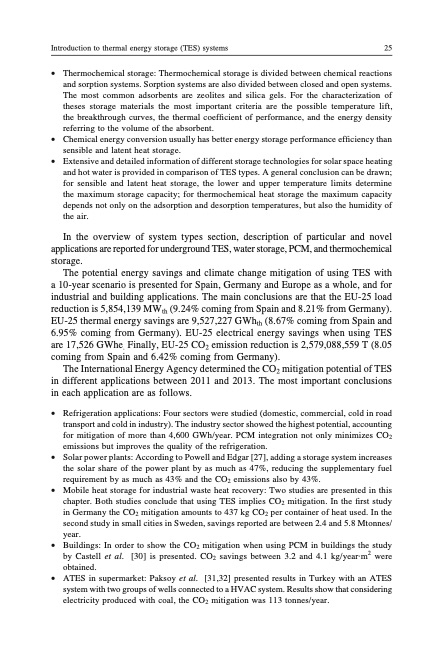
PDF Publication Title:
Text from PDF Page: 025
Introduction to thermal energy storage (TES) systems 25 ∑ Thermochemical storage: Thermochemical storage is divided between chemical reactions and sorption systems. Sorption systems are also divided between closed and open systems. The most common adsorbents are zeolites and silica gels. For the characterization of theses storage materials the most important criteria are the possible temperature lift, the breakthrough curves, the thermal coefficient of performance, and the energy density referring to the volume of the absorbent. ∑ Chemical energy conversion usually has better energy storage performance efficiency than sensible and latent heat storage. ∑ Extensive and detailed information of different storage technologies for solar space heating and hot water is provided in comparison of TES types. A general conclusion can be drawn; for sensible and latent heat storage, the lower and upper temperature limits determine the maximum storage capacity; for thermochemical heat storage the maximum capacity depends not only on the adsorption and desorption temperatures, but also the humidity of the air. In the overview of system types section, description of particular and novel applications are reported for underground TES, water storage, PCM, and thermochemical storage. The potential energy savings and climate change mitigation of using TES with a 10-year scenario is presented for Spain, Germany and Europe as a whole, and for industrial and building applications. The main conclusions are that the EU-25 load reduction is 5,854,139 MWth (9.24% coming from Spain and 8.21% from Germany). EU-25 thermal energy savings are 9,527,227 GWhth (8.67% coming from Spain and 6.95% coming from Germany). EU-25 electrical energy savings when using TES are 17,526 GWhe. Finally, EU-25 CO2 emission reduction is 2,579,088,559 T (8.05 coming from Spain and 6.42% coming from Germany). The International Energy Agency determined the CO2 mitigation potential of TES in different applications between 2011 and 2013. The most important conclusions in each application are as follows. ∑ Refrigeration applications: Four sectors were studied (domestic, commercial, cold in road transport and cold in industry). The industry sector showed the highest potential, accounting for mitigation of more than 4,600 GWh/year. PCM integration not only minimizes CO2 emissions but improves the quality of the refrigeration. ∑ Solar power plants: According to Powell and Edgar [27], adding a storage system increases the solar share of the power plant by as much as 47%, reducing the supplementary fuel requirement by as much as 43% and the CO2 emissions also by 43%. ∑ Mobile heat storage for industrial waste heat recovery: Two studies are presented in this chapter. Both studies conclude that using TES implies CO2 mitigation. In the first study in Germany the CO2 mitigation amounts to 437 kg CO2 per container of heat used. In the second study in small cities in Sweden, savings reported are between 2.4 and 5.8 Mtonnes/ year. ∑ Buildings: In order to show the CO2 mitigation when using PCM in buildings the study by Castell et al. [30] is presented. CO2 savings between 3.2 and 4.1 kg/year·m2 were obtained. ∑ ATES in supermarket: Paksoy et al. [31,32] presented results in Turkey with an ATES system with two groups of wells connected to a HV AC system. Results show that considering electricity produced with coal, the CO2 mitigation was 113 tonnes/year.PDF Image | Introduction to thermal energy storage TES systems

PDF Search Title:
Introduction to thermal energy storage TES systemsOriginal File Name Searched:
TES-introduction.pdfDIY PDF Search: Google It | Yahoo | Bing
Turbine and System Plans CAD CAM: Special for this month, any plans are $10,000 for complete Cad/Cam blueprints. License is for one build. Try before you buy a production license. More Info
Waste Heat Power Technology: Organic Rankine Cycle uses waste heat to make electricity, shaft horsepower and cooling. More Info
All Turbine and System Products: Infinity Turbine ORD systems, turbine generator sets, build plans and more to use your waste heat from 30C to 100C. More Info
CO2 Phase Change Demonstrator: CO2 goes supercritical at 30 C. This is a experimental platform which you can use to demonstrate phase change with low heat. Includes integration area for small CO2 turbine, static generator, and more. This can also be used for a GTL Gas to Liquids experimental platform. More Info
Introducing the Infinity Turbine Products Infinity Turbine develops and builds systems for making power from waste heat. It also is working on innovative strategies for storing, making, and deploying energy. More Info
Need Strategy? Use our Consulting and analyst services Infinity Turbine LLC is pleased to announce its consulting and analyst services. We have worked in the renewable energy industry as a researcher, developing sales and markets, along with may inventions and innovations. More Info
Made in USA with Global Energy Millennial Web Engine These pages were made with the Global Energy Web PDF Engine using Filemaker (Claris) software.
Sand Battery Sand and Paraffin for TES Thermo Energy Storage More Info
| CONTACT TEL: 608-238-6001 Email: greg@infinityturbine.com | RSS | AMP |